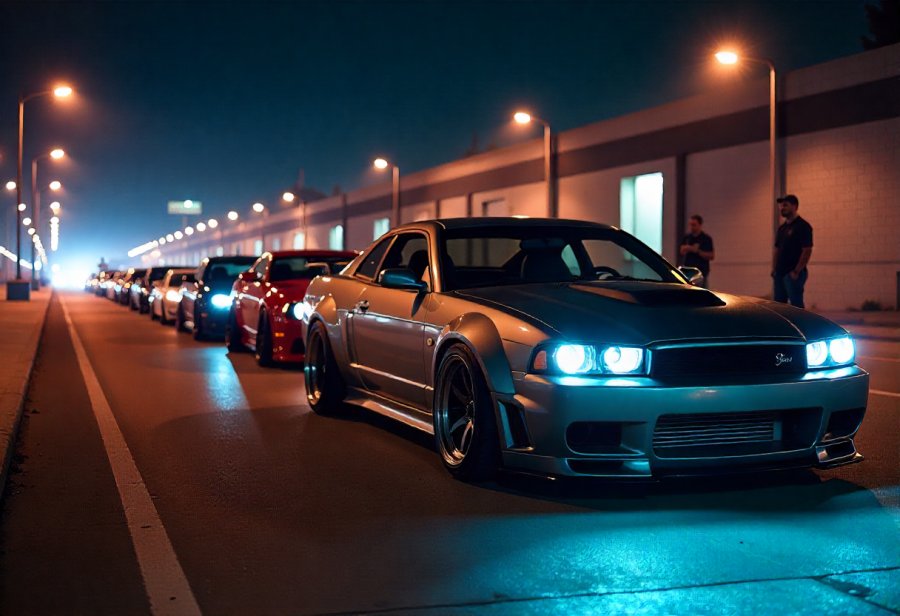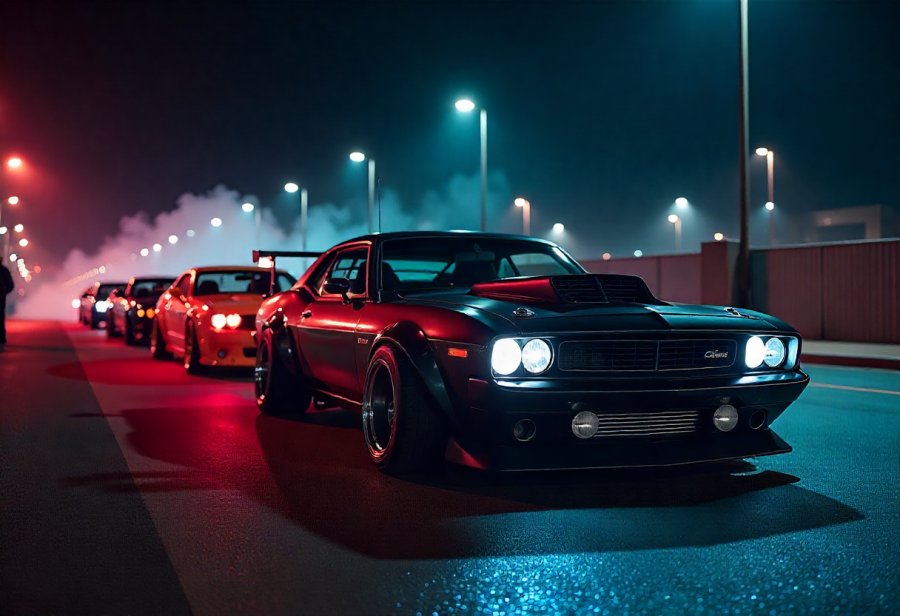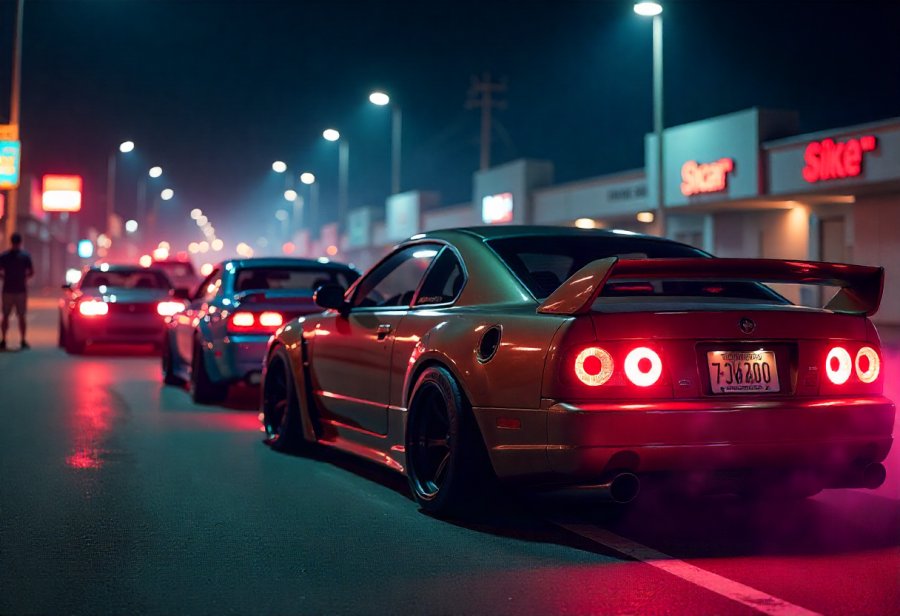
Underground street racing is more than just a thrill of speed—it’s a clandestine universe where loyalty, brotherhood, and identity intertwine beneath neon-lit nights. As racers gather in hidden locations, they forge unbreakable bonds through shared risks, sacrifices, and a collective passion for rebellion. This culture, rooted in decades of history, evolves with technology and media, yet its core remains centered on trust and kinship. Drivers and crews support each other amid legal threats and dangers, transforming fleeting adrenaline into lifelong friendships. But what keeps this raw, rebellious scene alive despite mounting restrictions? The answer lies in its resilient spirit and the deep human connections that fuel it. In the shadows, these bonds turn high-octane races into powerful rituals of loyalty, forging a community that endures through shared sacrifices and unwavering trust—proof that sometimes, the strongest bonds are forged in the dark.

Underground Racing: The Heartbeat of Urban Shadows
Underground street racing is a vibrant, pulse-pounding part of urban life that thrives in the shadows. It’s a scene where speed, skill, and rebellion come together under the cover of night, far from the watchful eyes of law enforcement. Racers gather in hidden locations—abandoned warehouses, quiet backstreets, or deserted industrial zones—forming tight-knit communities built on trust and shared adrenaline. These clandestine meetings foster a sense of exclusivity, where everyone knows the unspoken rules and the risks involved.
Unlike formal motorsport events, underground racing isn’t organized or regulated. It’s spontaneous, unpredictable, and fueled by pure passion for pushing limits. Drivers modify their cars relentlessly, squeezing out every bit of performance while also customizing for style and individuality. The scene’s energy is amplified by the roar of engines, tire smoke, and the glow of city lights, creating an electrifying atmosphere that’s as dangerous as it is exhilarating.
Loyalty and camaraderie underpin this culture deeply. Racers often form crews that act as extended families, supporting each other through late-night tuning, shared victories, and moments of danger. These bonds are forged in the fires of countless runs, broken down cars, and stories of daring escapes. Knowing someone has your back makes the risks more manageable, turning fleeting adrenaline into lasting trust. It’s this sense of kinship that keeps the scene alive, even as authorities crack down harder and social stigma persists.
The diversity within underground racing reflects the urban environments it inhabits. Youth from various backgrounds—students, young professionals, locals—find common ground in their love for cars and the night’s thrill. Their shared language of modifications, techniques, and code of respect creates a unique cultural space where self-expression flourishes and community bonds deepen. Despite social differences, they unite through their passion, keeping the scene resilient and thriving in the shadows.
In essence, underground street racing is more than just a pursuit of speed. It’s a powerful expression of human connection, loyalty, and resilience. Beneath the roar of engines and the shimmer of city lights lies a culture rooted in brotherhood and shared risks. These bonds turn fleeting moments of adrenaline into lifelong friendships, making the scene more than just a race—it’s a community that endures through loyalty, creativity, and unbreakable trust.
From Rebellion to Iconic Phenomenon: The Origins of Street Racing
Street racing’s roots stretch back to the 1950s and ’60s, when young car enthusiasts in cities started pushing their muscle cars and hot rods beyond the limits of legal tracks. Back then, it was all about finding secret spots—quiet neighborhoods, abandoned industrial zones, or deserted streets—where they could test their cars and chase that adrenaline rush without the watchful eye of authorities. These early races weren’t organized events but spontaneous gatherings fueled by rebellion and a desire for speed, often spread through word of mouth among close-knit groups. The crews that formed around these gatherings weren’t just about racing; they became a source of identity and pride, bonding members through late-night drives, shared victories, and mutual support.
As cars became more accessible and modification culture grew, the underground scene expanded in size and complexity. Enthusiasts started customizing their vehicles with performance parts, eye-catching paint jobs, and unique touches to stand out from the crowd. Movies like “The Fast and the Furious” in the early 2000s played a major role in glamorizing street racing, transforming it from a fringe activity into a global phenomenon. This media attention made the scene’s rebellious spirit and craftsmanship widely appealing, inspiring more young people to join crews and emulate their favorite racers. Social media further fueled this growth, allowing organizers to coordinate clandestine races and share footage across borders, blurring the lines between underground culture and mainstream entertainment.
Economic and social factors also pushed the scene’s expansion. In many urban areas, a lack of legal racing venues and recreational options drove youth toward the streets. For marginalized communities, street racing became a way to carve out a sense of identity and belonging outside societal norms. The scene’s rebellious image, coupled with the thrill of customization and speed, attracted a broad range of participants. Over time, legendary figures—both real racers and fictional icons—shaped the mythology of street racing, emphasizing themes of independence, skill, and defiance. These stories added layers of identity and tradition, fueling the scene’s resilience and allure.
Today, the roots of street racing remain strong, even as the scene continues to evolve with new technology. Electric vehicles, neon lighting, and innovative wraps now complement traditional modifications, blending the old with the new. The community’s digital presence keeps it connected, with social media platforms enabling quick organization of secret events and sharing of accomplishments. Despite crackdowns and safety concerns, the core spirit endures: a love for speed, creativity, and brotherhood that can’t be suppressed. The history of underground racing is a testament to human innovation and resilience—an ongoing story of rebellion, community, and the pursuit of adrenaline that continues to shape urban culture worldwide.

Modern Underbelly: The Resilient Spirit of Street Racing Today
Today, underground street racing remains a dynamic and resilient element of urban culture, fueled by a strong sense of community that refuses to fade despite mounting challenges. Racers still gather in secret locations—abandoned roads, industrial zones, and secluded parking lots—where they can push their cars to the limit away from law enforcement’s watchful eyes. These spots provide the space and privacy needed for high-stakes races, keeping the adrenaline alive even as authorities tighten restrictions.
Social media plays a pivotal role in maintaining this scene’s vitality. Platforms like Instagram, TikTok, and YouTube allow crews to share footage, showcase their modifications, and organize clandestine events across cities and borders. This digital connectivity keeps the community tight-knit, constantly introducing fresh talent and ideas. Modern racers experiment with electric vehicles, neon lighting, and custom wraps, blending tradition with innovation to stand out and express their unique style.
The demographic behind underground racing remains diverse but united by a shared passion for speed and self-expression. Young adults, often in their late teens to early thirties, come from different backgrounds but find common ground in their love for cars and the thrill of the night. Crews function as extended families, supporting each other through late-night tuning sessions, repairs, and shared victories. Loyalty runs deep, with members risking legal trouble or danger to protect their crew’s reputation and safety.
Despite legal threats and safety concerns, the spirit of brotherhood persists strongly. Night races serve as bonding rituals, where trust and camaraderie are reinforced beneath the glow of engine lights. These moments are more than competitions—they’re rites of connection. Racers exchange quick words of encouragement, celebrate wins, and support each other through setbacks, forging relationships that often extend far beyond the streets.
The scene’s ability to adapt keeps it alive. Technological advances like electric powertrains and innovative modifications continue to push boundaries, inspiring creativity and performance. Organizers and crews use encrypted messages and secret locations to stay ahead of police crackdowns, ensuring the scene’s survival. This resilience is rooted in collective loyalty and a shared drive to innovate, making underground racing a continuously evolving expression of rebellion and community.
At its core, underground street racing is about more than just speed. It’s a culture built on trust, sacrifice, and kinship. The bonds formed in the shadows—fueled by shared risks and mutual support—are what sustain the scene. These relationships transform fleeting adrenaline moments into lifelong friendships, turning a high-octane pursuit into a powerful expression of loyalty and belonging.
In the end, the resilience of this culture highlights a fundamental truth: human connection thrives in moments of vulnerability and rebellion. Beneath the roar of engines and the glow of streetlights, a deep sense of kinship endures. The community’s strength lies in these human ties, which turn fleeting moments of speed into lasting bonds, ensuring underground street racing remains a vital, thriving part of urban life.
For those interested in exploring this vibrant scene further, there are many resources and communities dedicated to underground street racing. Learning more about the culture and safety tips can help newcomers appreciate the scene responsibly, while seasoned racers often share their knowledge through dedicated websites like Street Racing FAQ. Embracing these insights allows enthusiasts to stay connected and informed, ensuring the tradition continues safely and passionately.
Loyalty in Motion: The Unbreakable Bonds of Street Racing Brotherhood
In underground street racing, loyalty isn’t just a word; it’s the foundation that holds the entire scene together. Trust is built through shared experiences—late nights tuning engines, supporting each other through breakdowns, and standing united against external threats like police crackdowns or rival crews. These bonds go beyond individual achievements, forging a sense of family where every member’s safety and reputation are intertwined. Knowing someone has your back in moments of danger transforms fleeting adrenaline into a powerful sense of belonging.
Crews are more than just racing teams—they’re extended families. The relationships formed are rooted in mutual support and sacrifice. Whether hiding evidence, covering for a teammate during a raid, or risking legal trouble to defend their reputation, racers demonstrate loyalty through actions that speak louder than words. These acts of devotion turn acquaintances into lifelong allies, turning the scene into a resilient community built on shared risks and collective trust.
Night races serve as powerful rituals that reinforce these bonds. Under the cover of darkness, racers gather in secret locations, exchanging quick words of encouragement and celebrating each other’s victories. The glow of engine lights and the roar of engines become symbols of unity, reminding everyone that they’re part of something bigger than just racing. These moments forge relationships that extend beyond the street, creating lifelong friendships rooted in loyalty and mutual respect.
The loyalty among racers is tested constantly. Facing threats from law enforcement or rival groups, members stand firm, knowing their support is what keeps the scene alive. Stories of risking arrest, injury, or even danger to protect each other are common and reinforce the deep sense of brotherhood. Acts of sacrifice—covering for a crew member or risking personal safety—are seen as badges of loyalty, strengthening bonds that withstand external pressures.
This culture of unwavering commitment is what sustains underground racing through challenges. It’s about more than winning races; it’s about safeguarding each other’s futures and honoring the trust that’s been built over countless shared moments. The loyalty isn’t superficial—it’s rooted in genuine care, forged in the fires of risk and shared passion. These relationships turn fleeting moments of speed into enduring connections that keep the community resilient and thriving.
At its core, underground street racing is a testament to the power of human connection. Beyond the roar of engines and the thrill of the race, it’s the bonds of brotherhood and loyalty that define the scene. These relationships transform fleeting adrenaline into lifelong friendships, proving that even in rebellion, the strongest force is the trust and support shared among racers. It’s this unbreakable kinship that ensures the scene endures, resilient in the face of adversity.

Beyond the Speed: The Enduring Culture of Loyalty and Connection in Street Racing
Underground street racing is more than just a pursuit of speed; it embodies a deep sense of community, loyalty, and brotherhood that endures beneath the surface. The bonds forged among racers are rooted in shared risks and mutual support, transforming fleeting moments of adrenaline into lasting relationships. These connections are the true engine of the scene, turning individual races into collective experiences built on trust and sacrifice.
At its core, this culture reveals that human connection often thrives in moments of vulnerability and rebellion. Beneath the roar of engines and the glow of streetlights, a human side persists—one driven by resilience, kinship, and a need for belonging. Racers see each other as family, bound not just by cars but by unspoken codes of loyalty and shared purpose. The modified machines become symbols of identity, but it’s the relationships behind them that truly give the scene its strength.
Loyalty is demonstrated through action, not just words. Racers support each other during police raids, cover for one another’s mistakes, and risk personal safety to protect the crew’s reputation. These acts of devotion turn acquaintances into lifelong allies, creating a resilient community that withstands external threats. The willingness to sacrifice—whether risking arrest, injury, or social stigma—cements bonds that go beyond the race itself, forging a collective resilience rooted in trust.
Night races serve as powerful rituals that reinforce these bonds. Under the cover of darkness, crews gather in secret locations, sharing quick words of encouragement and celebrating each other’s victories. In these moments, the glow of engine lights and the roar of speed transform into symbols of unity and shared purpose. These rituals deepen relationships, turning fleeting adrenaline into enduring friendships built on loyalty and respect.
Despite increasing legal pressures and safety concerns, the spirit of brotherhood remains unbreakable. The scene’s ability to adapt—using encrypted communication, innovative modifications, and secret rendezvous—keeps the community alive. Loyalty and collective drive fuel this resilience, allowing underground racing to continue thriving in the shadows of society. It’s a testament to how bonds formed in risk and rebellion can forge a powerful, enduring culture.
Ultimately, underground street racing reflects a fundamental truth: human connection and kinship often flourish in the most unlikely places. Beneath the chaos and adrenaline lies a community sustained by trust, sacrifice, and shared experience. These relationships turn fleeting moments of speed into lifelong bonds, proving that even in rebellion, the strongest force is the unity forged among those who race in the shadows.


